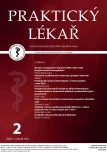Using social networks and the internet to promote vaccination
Authors:
J. Mareš
Authors‘ workplace:
Přednostka prof. MUDr. Lenka Borská, PhD.
; Lékařská fakulta v Hradci Králové
; Ústav preventivního lékařství
; Univerzita Karlova v Praze
Published in:
Prakt. Lék. 2023; 103(2): 55-62
Category:
Of different specialties
Overview
This systematic review aims to report currently available familiarities in developed countries regarding the employment of social media and the internet to effectively persuade laypeople about the safety of vaccines. Given it possession of multiple anti-vaccination platforms and campaigns, social media platforms and the internet may in fact pose as a greater source discouragement for a layperson. On the other hand, they can also serve as a new opportunity for health professionals and lay vaccination supporters alike to respond in an accessible form to laypeople vaccine hesitation as well as react to misinformation given to the public in a timely matter. The following study consists of three parts.
The first part describes the hindrances that prevent health professionals from promoting vaccination on social media. The underlying problem is that vaccine opponents have gained a time advantage. Early on, they began using social media as an effective platform to spread misinformation and fear of vaccination. Health organizations however have fallen behind as they hesitated for a long time and now it seems difficult to catch up with new modes of communication (difficulties to keep up with technological innovations, lack of management support delayed by multi-stage approval processes, etc.).
The second part deals with the use of social media in vaccination promotion. Live conversations with laypeople on social media including direct answers to their questions prove to be the most effective way. To be able to persuade the public, different interventional approaches need to be combined. A one-size-fits-all approach cannot be considered as the most effective form. From a linguistic point of view, influences against vaccination are written more simply and comprehensibly than the inputs of health professionals. Which should certainly be considered by health workers in the future.
The third part focuses on the form of controversies between lay supporters and opponents of vaccination in social media. For example, Czech research has found that opposition of attitudes tends to take three forms: 1. opposition by “stigmatizing” opponents, 2. opposition by “majority? versus individual” dichotomy, 3. opposition by “reason versus irrationality” dichotomy.
Keywords:
vaccination – Internet – Social networks – research – persuasion by laypeople – controversy
Sources
1. Altay S, Mercier H. Framing messages for vaccination supporters. J Exp Psychol Appl 2020; 26(4): 567–578.
2. Boudreau H, Singh N, Boyd CJ. Understanding the impact of social media information and misinformation producers on health information seeking. Comment on “Health information seeking behaviors on social media during the COVID-19 pandemic among American social networking site users: survey study”. J Med Internet Res 2022; 24(2): e31415.
3. Brunson EK. Identifying parents who are amenable to pro-vaccination conversations. Glob Pediatr Health 2015; 2(1): 1–7.
4. Daley MF, Glanz JM. Using social media to increase vaccine acceptance. Acad Pediatr 2021; 21(4S): S32−S33.
5. Faasse K, Chatman CJ, Martin LR. A comparison of language use in pro-and anti-vaccination comments in response to a high profile Facebook post. Vaccine 2016; 34(47): 5808–5814.
6. Karafillakis E, Simas C, Olsson K, et al. Methods for social media monitoring related to vaccination: systematic scoping review. JMIR Public Health Surveill 2021; 7(2): e17149.
7. Karlsen R, Steen-Johnsen K, Wollebæk D, et al. Echo chamber and trench warfare dynamics in online debates. Eur J Commun 2017; 32(3): 257–273.
8. Martin B. (2014). What SAVN doesn’t want you to read [online]. Dostupné z: https://www.bmartin.cc/pubs/14savn/index.html [cit. 2023-03-04].
9. Martin B. An experience with vaccination gatekeepers. Social Epistemol Rev 2016; 5(10): 27–33.
10. McKeever BW, McKeever R, Holton AE, et al. Silent majority: childhood vaccinations and antecedents to communicative action. Mass Commun Soc 2016; 19: 476–498.
11. Milton H, Mercier H. Cognitive obstacles to pro-vaccination beliefs. Trends Cogn Sci 2015; 19(11): 633–636.
12. Navin MC, Wasserman JA, Ahmad M, et al. Vaccine education, reasons for refusal, and vaccination behavior. Am J Prev Med 2019; 56(3): 359–367.
13. Okuhara T, Ishikawa H, Okada M, et al. Readability comparison of pro- and anti-HPV-vaccination online messages in Japan. Patient Educ Couns 2017; 100(10): 1859–1866.
14. Richards B. The emotional public sphere and its importance: Freedom of speech as a case study. Int J Commun 2018; 12: 2040–2051.
15. Stahl P, Cohen R, Denis F, et al. The impact of the web and social networks on vaccination. New challenges and opportunities offered to fight against vaccine hesitancy. Med Mal Infect 2016; 46(3): 117–122.
16. Steffens M, Dunn AG, Leask J, et al. Using social media for vaccination promotion: Practices and challenges. Digit Health 2020 [online]. Dostupné z: https://journals.sagepub.com/ doi/10.1177/2055207620970785 [cit. 2023-03-04].
17. Steffens M, Dunn AG, Wiley KE. How organisations promoting vaccination respond to misinformation on social media: a qualitative investigation. BMC Public Health 2019; 19(1): 1348.
18. Vanderslott S. Exploring the meaning of pro-vaccine activism across two countries. Soc Sci Med 2019; 222(1): 59–66.
19. Vochocová L, Numerato D, Sedláčková T. Opting for polarizing emotions: strategies of Czech pro-vaccination discussants in the emotionalized public sphere and debate on measles epidemic. Int J Commun 2022; 16: 1006–1026.
20. Yaqub O, Castle-Clarke S, Sevdalis N, et al. Attitudes to vaccination: a critical review. Soc Sci Med 2014; 112(1): 1–11.
Labels
General practitioner for children and adolescents General practitioner for adultsArticle was published in
General Practitioner

2023 Issue 2
Most read in this issue
- Glucose management indicator (GMI) and its relationship to glycated haemoglobin
- Telemedicine and act on health services and conditions of their provision
- Time of onset of chronic diseases in the middle-aged population
- Using social networks and the internet to promote vaccination
